tow bar DODGE DURANGO 2006 2.G Owners Manual
[x] Cancel search | Manufacturer: DODGE, Model Year: 2006, Model line: DURANGO, Model: DODGE DURANGO 2006 2.GPages: 440, PDF Size: 6.63 MB
Page 70 of 440
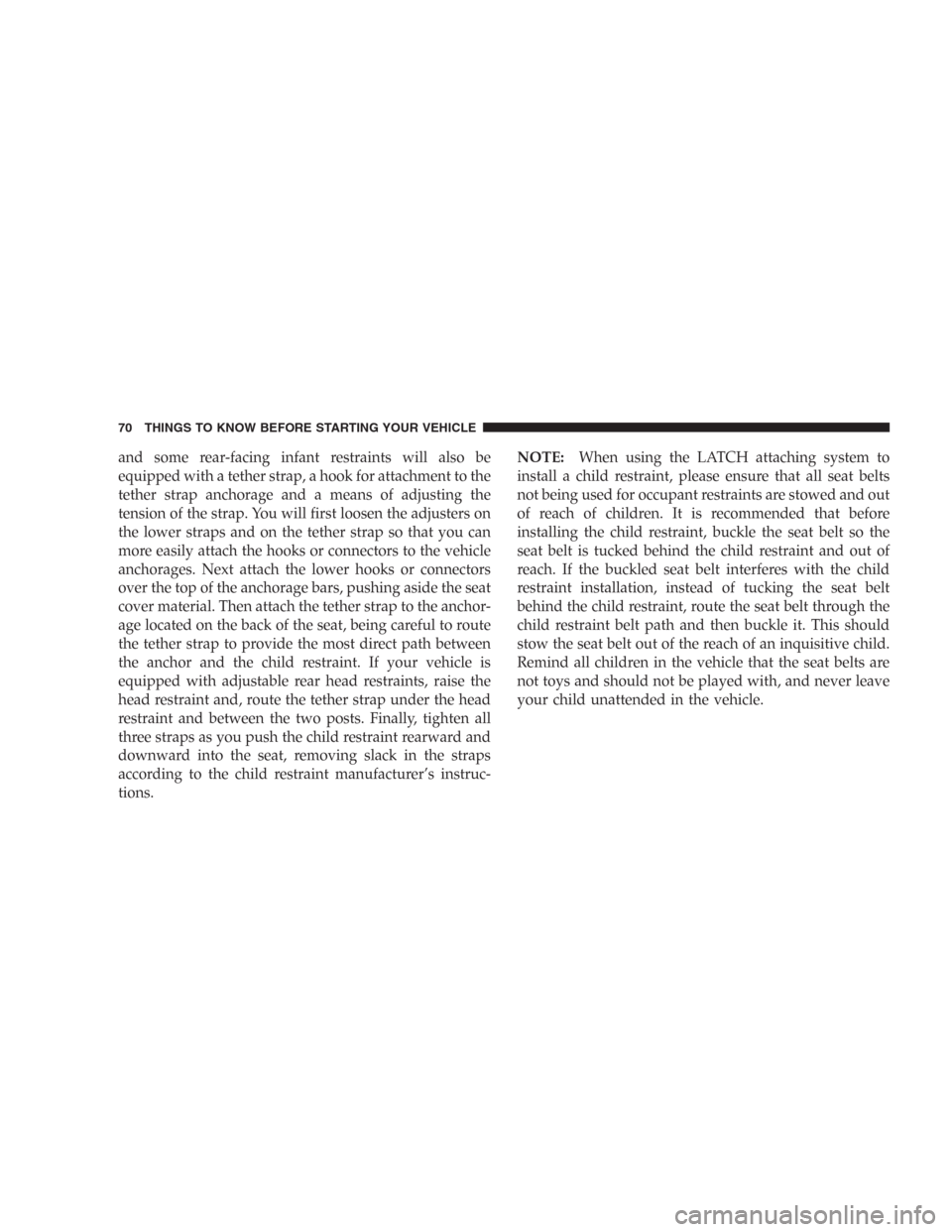
and some rear-facing infant restraints will also be
equipped with a tether strap, a hook for attachment to the
tether strap anchorage and a means of adjusting the
tension of the strap. You will first loosen the adjusters on
the lower straps and on the tether strap so that you can
more easily attach the hooks or connectors to the vehicle
anchorages. Next attach the lower hooks or connectors
over the top of the anchorage bars, pushing aside the seat
cover material. Then attach the tether strap to the anchor-
age located on the back of the seat, being careful to route
the tether strap to provide the most direct path between
the anchor and the child restraint. If your vehicle is
equipped with adjustable rear head restraints, raise the
head restraint and, route the tether strap under the head
restraint and between the two posts. Finally, tighten all
three straps as you push the child restraint rearward and
downward into the seat, removing slack in the straps
according to the child restraint manufacturer’s instruc-
tions.NOTE:When using the LATCH attaching system to
install a child restraint, please ensure that all seat belts
not being used for occupant restraints are stowed and out
of reach of children. It is recommended that before
installing the child restraint, buckle the seat belt so the
seat belt is tucked behind the child restraint and out of
reach. If the buckled seat belt interferes with the child
restraint installation, instead of tucking the seat belt
behind the child restraint, route the seat belt through the
child restraint belt path and then buckle it. This should
stow the seat belt out of the reach of an inquisitive child.
Remind all children in the vehicle that the seat belts are
not toys and should not be played with, and never leave
your child unattended in the vehicle.
70 THINGS TO KNOW BEFORE STARTING YOUR VEHICLE
Page 298 of 440
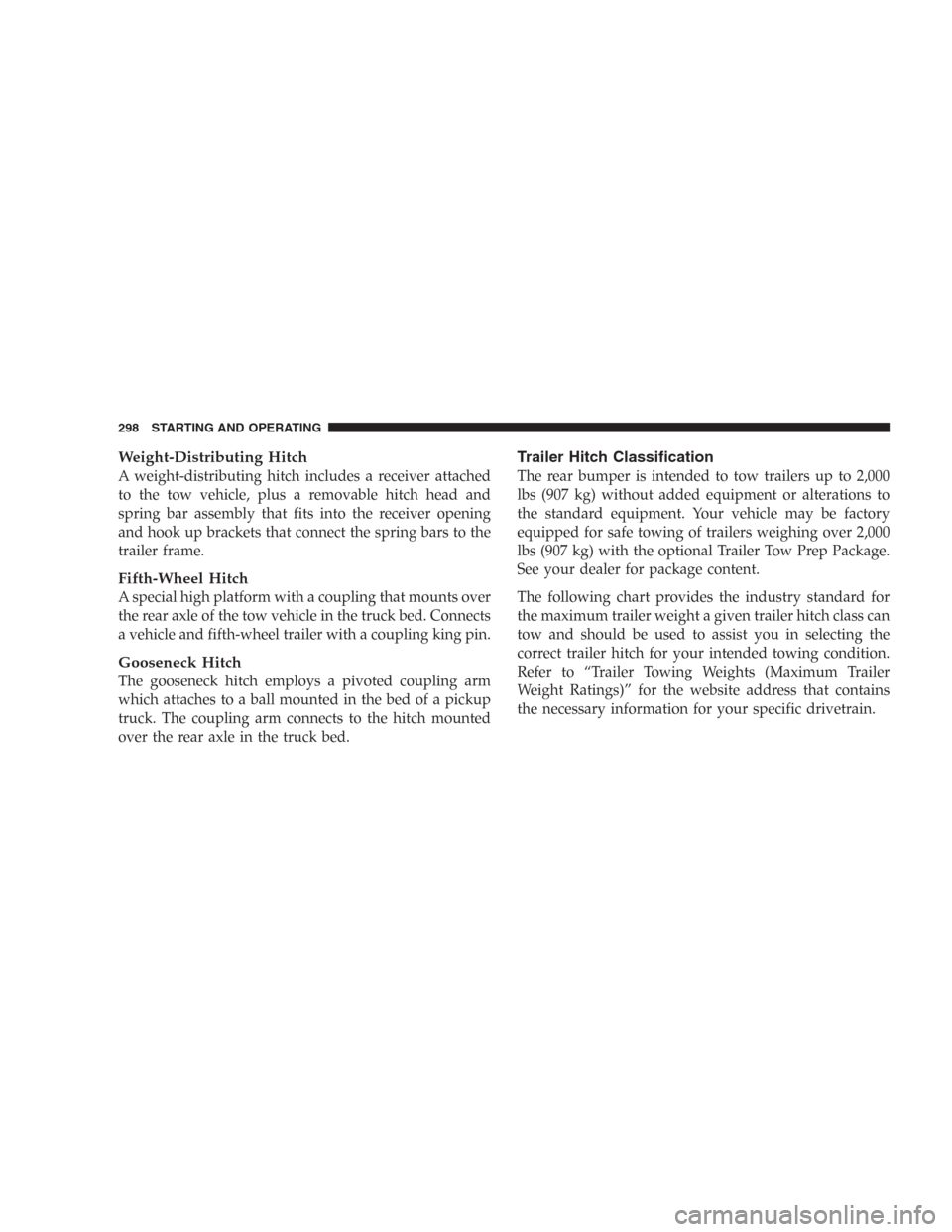
Weight-Distributing Hitch
A weight-distributing hitch includes a receiver attached
to the tow vehicle, plus a removable hitch head and
spring bar assembly that fits into the receiver opening
and hook up brackets that connect the spring bars to the
trailer frame.
Fifth-Wheel Hitch
A special high platform with a coupling that mounts over
the rear axle of the tow vehicle in the truck bed. Connects
a vehicle and fifth-wheel trailer with a coupling king pin.
Gooseneck Hitch
The gooseneck hitch employs a pivoted coupling arm
which attaches to a ball mounted in the bed of a pickup
truck. The coupling arm connects to the hitch mounted
over the rear axle in the truck bed.
Trailer Hitch Classification
The rear bumper is intended to tow trailers up to 2,000
lbs (907 kg) without added equipment or alterations to
the standard equipment. Your vehicle may be factory
equipped for safe towing of trailers weighing over 2,000
lbs (907 kg) with the optional Trailer Tow Prep Package.
See your dealer for package content.
The following chart provides the industry standard for
the maximum trailer weight a given trailer hitch class can
tow and should be used to assist you in selecting the
correct trailer hitch for your intended towing condition.
Refer to “Trailer Towing Weights (Maximum Trailer
Weight Ratings)” for the website address that contains
the necessary information for your specific drivetrain.
298 STARTING AND OPERATING
Page 310 of 440
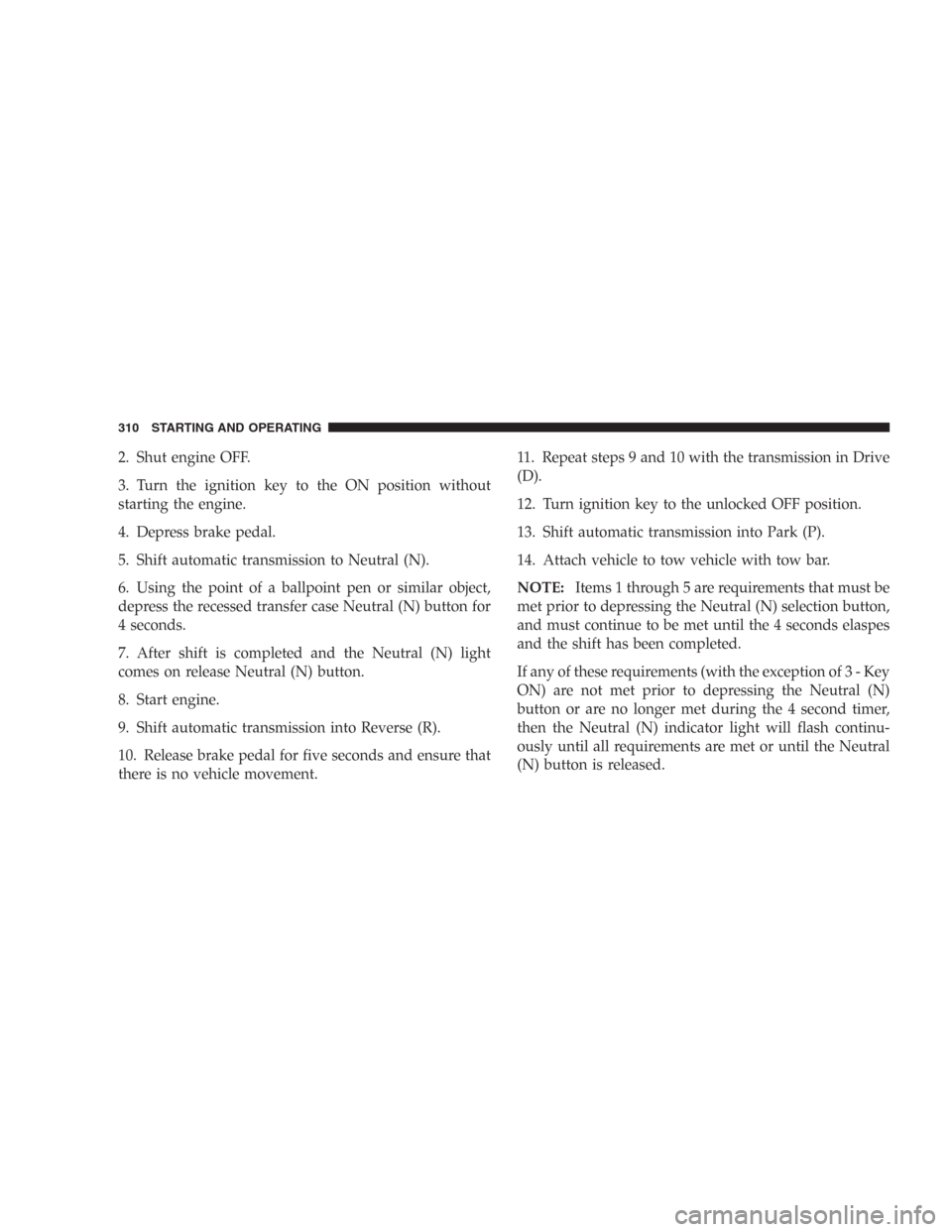
2. Shut engine OFF.
3. Turn the ignition key to the ON position without
starting the engine.
4. Depress brake pedal.
5. Shift automatic transmission to Neutral (N).
6. Using the point of a ballpoint pen or similar object,
depress the recessed transfer case Neutral (N) button for
4 seconds.
7. After shift is completed and the Neutral (N) light
comes on release Neutral (N) button.
8. Start engine.
9. Shift automatic transmission into Reverse (R).
10. Release brake pedal for five seconds and ensure that
there is no vehicle movement.11. Repeat steps 9 and 10 with the transmission in Drive
(D).
12. Turn ignition key to the unlocked OFF position.
13. Shift automatic transmission into Park (P).
14. Attach vehicle to tow vehicle with tow bar.
NOTE:Items 1 through 5 are requirements that must be
met prior to depressing the Neutral (N) selection button,
and must continue to be met until the 4 seconds elaspes
and the shift has been completed.
If any of these requirements (with the exception of3-Key
ON) are not met prior to depressing the Neutral (N)
button or are no longer met during the 4 second timer,
then the Neutral (N) indicator light will flash continu-
ously until all requirements are met or until the Neutral
(N) button is released.
310 STARTING AND OPERATING
Page 312 of 440
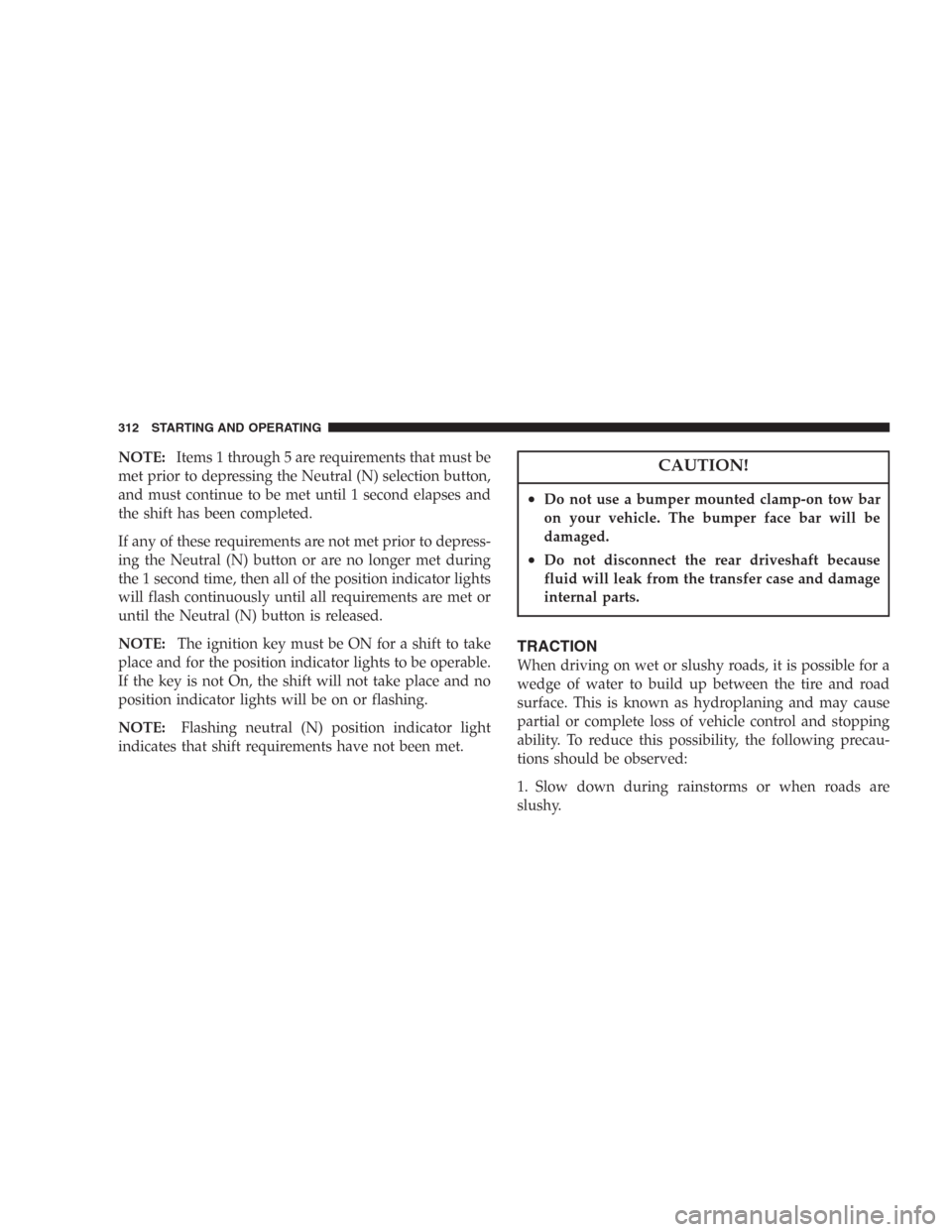
NOTE:Items 1 through 5 are requirements that must be
met prior to depressing the Neutral (N) selection button,
and must continue to be met until 1 second elapses and
the shift has been completed.
If any of these requirements are not met prior to depress-
ing the Neutral (N) button or are no longer met during
the 1 second time, then all of the position indicator lights
will flash continuously until all requirements are met or
until the Neutral (N) button is released.
NOTE:The ignition key must be ON for a shift to take
place and for the position indicator lights to be operable.
If the key is not On, the shift will not take place and no
position indicator lights will be on or flashing.
NOTE:Flashing neutral (N) position indicator light
indicates that shift requirements have not been met.CAUTION!
•Do not use a bumper mounted clamp-on tow bar
on your vehicle. The bumper face bar will be
damaged.
•Do not disconnect the rear driveshaft because
fluid will leak from the transfer case and damage
internal parts.
TRACTION
When driving on wet or slushy roads, it is possible for a
wedge of water to build up between the tire and road
surface. This is known as hydroplaning and may cause
partial or complete loss of vehicle control and stopping
ability. To reduce this possibility, the following precau-
tions should be observed:
1. Slow down during rainstorms or when roads are
slushy.
312 STARTING AND OPERATING
Page 429 of 440
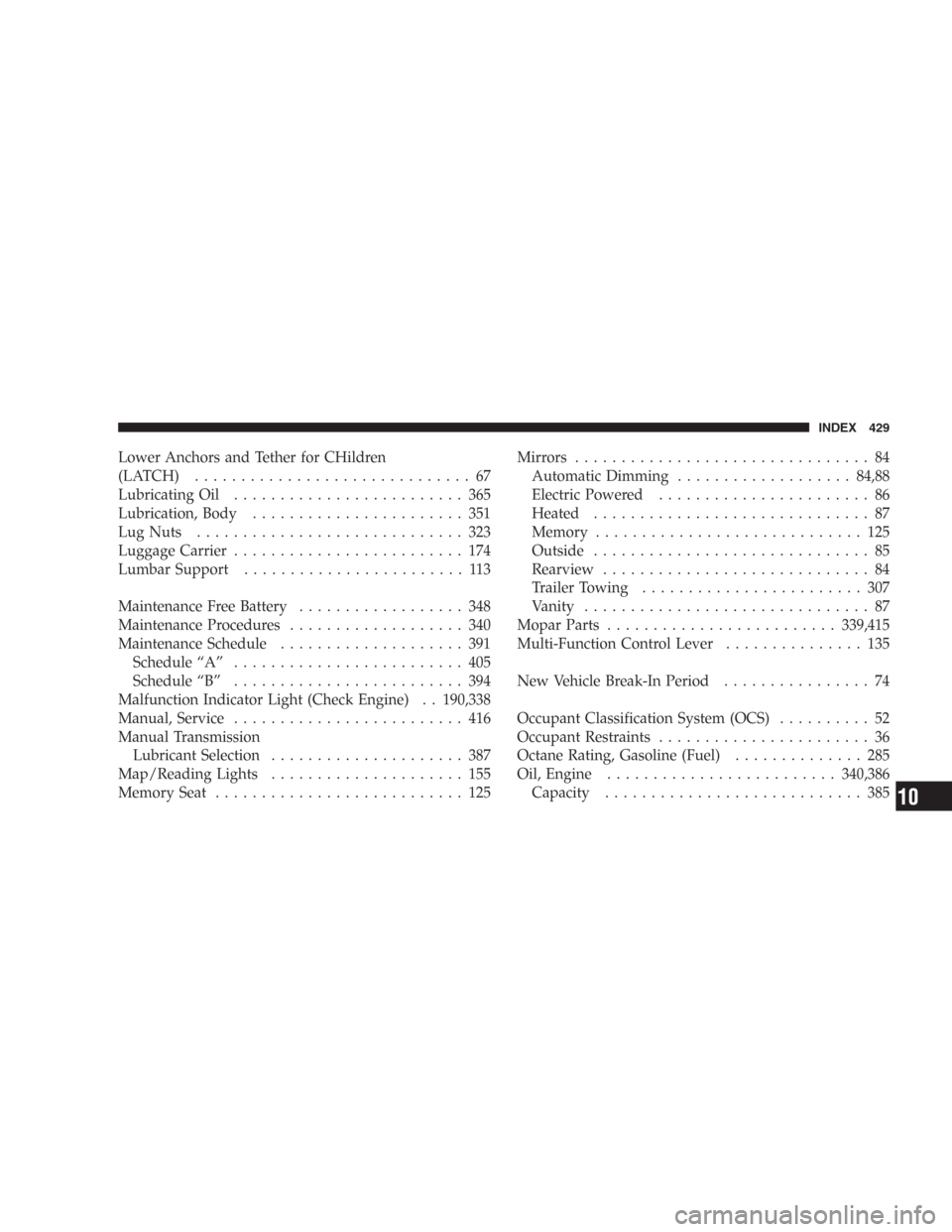
Lower Anchors and Tether for CHildren
(LATCH).............................. 67
Lubricating Oil......................... 365
Lubrication, Body....................... 351
Lug Nuts............................. 323
Luggage Carrier......................... 174
Lumbar Support........................ 113
Maintenance Free Battery.................. 348
Maintenance Procedures................... 340
Maintenance Schedule.................... 391
Schedule “A”......................... 405
Schedule “B”......................... 394
Malfunction Indicator Light (Check Engine) . . 190,338
Manual, Service......................... 416
Manual Transmission
Lubricant Selection..................... 387
Map/Reading Lights..................... 155
Memory Seat........................... 125Mirrors................................ 84
Automatic Dimming...................84,88
Electric Powered....................... 86
Heated.............................. 87
Memory............................. 125
Outside.............................. 85
Rearview............................. 84
Trailer Towing........................ 307
Vanity............................... 87
Mopar Parts.........................339,415
Multi-Function Control Lever............... 135
New Vehicle Break-In Period................ 74
Occupant Classification System (OCS).......... 52
Occupant Restraints....................... 36
Octane Rating, Gasoline (Fuel).............. 285
Oil, Engine.........................340,386
Capacity............................ 385
INDEX 429
10